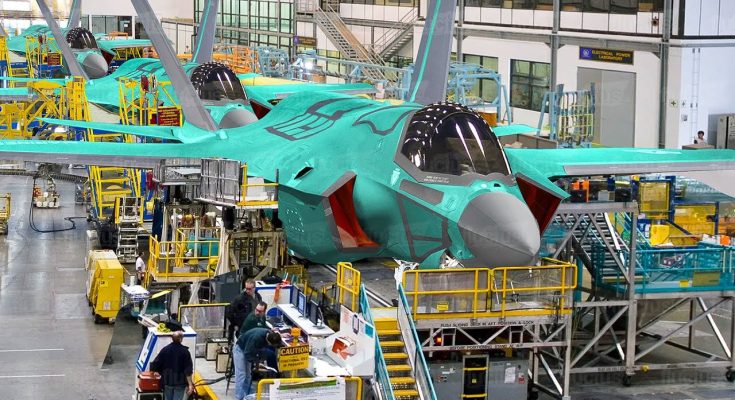The F-35 Lightning II is one of the most advanced and revolutionary fighter jets in the world, representing a multi-billion-dollar investment in next-generation military aviation. Manufactured by Lockheed Martin, the F-35 is designed to be a versatile, stealthy, and highly capable multirole fighter for a variety of missions, including air superiority, precision strikes, intelligence gathering, and electronic warfare. What makes the F-35 particularly impressive is its ability to serve multiple branches of the military — the Air Force, Navy, and Marine Corps — with three distinct variants: the F-35A, F-35B, and F-35C. This multi-billion-dollar program, which involves the production of thousands of jets, requires a highly sophisticated, state-of-the-art assembly line. Let’s dive into what happens inside the US F-35 assembly line.
The Scale and Complexity of the F-35 Program
The F-35 program is a massive undertaking, with over 3,000 aircraft scheduled for production, serving more than 15 countries around the world. Each F-35 costs roughly $80 million to $100 million, depending on the variant, and the program itself has become one of the most expensive military projects in history. Given the complexity of producing such an advanced fighter, the assembly line requires a highly efficient and cutting-edge production process.
Located at Lockheed Martin’s Fort Worth facility in Texas, this assembly line is a marvel of modern aerospace manufacturing. The process involves many stages, from the initial assembly of the airframe to final testing and delivery to the customer. Each F-35 is assembled using thousands of components, sourced from suppliers across the globe. The manufacturing of the aircraft requires an incredibly detailed and precise workflow, as the F-35 integrates stealth technologies, advanced avionics, and sophisticated weapons systems.
The Assembly Line: Step-by-Step
- Airframe Assembly: The first stage in the assembly process is the construction of the airframe. Large sections of the aircraft, such as the fuselage, wings, and tail, are produced separately at various sites and then brought together in Fort Worth. Precision is critical here, as the F-35 is a stealth aircraft, which means its design must reduce its radar cross-section. Therefore, the assembly line incorporates advanced techniques like robotic welding, automated riveting, and precision alignment to ensure that each part fits together seamlessly.
- Integration of Systems: After the airframe is assembled, various internal components are integrated. These include avionics, radar systems, communications equipment, and the cockpit. The F-35’s cockpit is especially sophisticated, featuring a glass cockpit with a high-tech heads-up display and an advanced sensor fusion system that provides the pilot with a comprehensive view of the battlefield. The systems integration stage is essential for ensuring that all components work together effectively.
- Stealth Coating and Testing: As a stealth fighter, the F-35’s ability to evade radar detection is crucial. To achieve this, the aircraft is coated with a special radar-absorbing material during the assembly process. This low observable coating is meticulously applied to minimize the aircraft’s radar signature. Once the airframe and systems are in place, the aircraft undergoes various tests to ensure its radar-stealth capabilities are intact.
- Final Assembly and Quality Control: After the primary systems are installed, the aircraft moves to the final assembly area. Here, the aircraft undergoes additional quality checks, including the installation of the landing gear, weapons systems, and engine. The engine, a Pratt & Whitney F135 turbofan, is a highly advanced component that powers the F-35’s supercruise capabilities. Each jet is subjected to rigorous quality control checks, ensuring that every part functions to the highest standard.
- Test Flights and Delivery: Once the assembly is complete, the F-35 undergoes several test flights to ensure that all systems are operational. These test flights cover a wide range of scenarios, from basic flight checks to advanced combat maneuvers, allowing engineers to verify the aircraft’s performance. After passing these tests, the jet is delivered to the customer, whether it’s the U.S. military or an allied nation.
Advanced Technologies and Automation
The assembly line for the F-35 incorporates some of the latest advancements in manufacturing technologies. Much of the process is robotic and automated, ensuring high precision and efficiency. Advanced 3D modeling and digital twins (virtual replicas of the aircraft) are used to guide the assembly process and ensure that every component is precisely aligned. Robotics plays a key role in performing highly repetitive tasks like riveting and drilling, reducing the risk of human error.
Lockheed Martin also uses augmented reality (AR) for maintenance and assembly operations, providing workers with real-time data overlays that improve efficiency and reduce mistakes. The factory’s use of lean manufacturing principles ensures that assembly processes are streamlined, reducing costs and time without compromising on quality.
Conclusion
Inside the US F-35 assembly line, the creation of one of the most advanced and lethal fighter jets in the world is a complex, highly precise operation. The assembly line integrates cutting-edge technologies, automation, and advanced materials to ensure that every F-35 produced is a top-tier product. From its stealth capabilities to its multirole versatility, the F-35 represents the pinnacle of modern aerospace engineering, and the assembly process reflects the scale and ambition of this multi-billion-dollar program. As the F-35 continues to be delivered to the U.S. military and allied nations, it will remain a cornerstone of air combat for decades to come.



